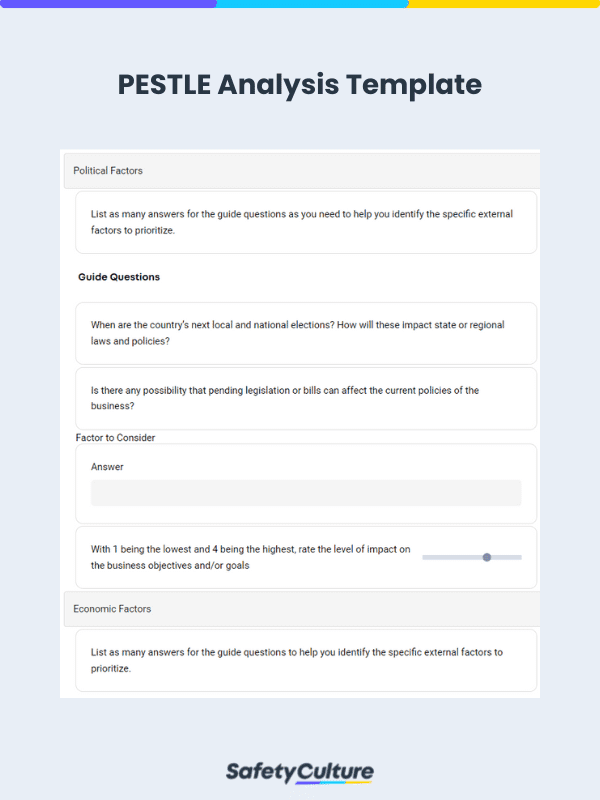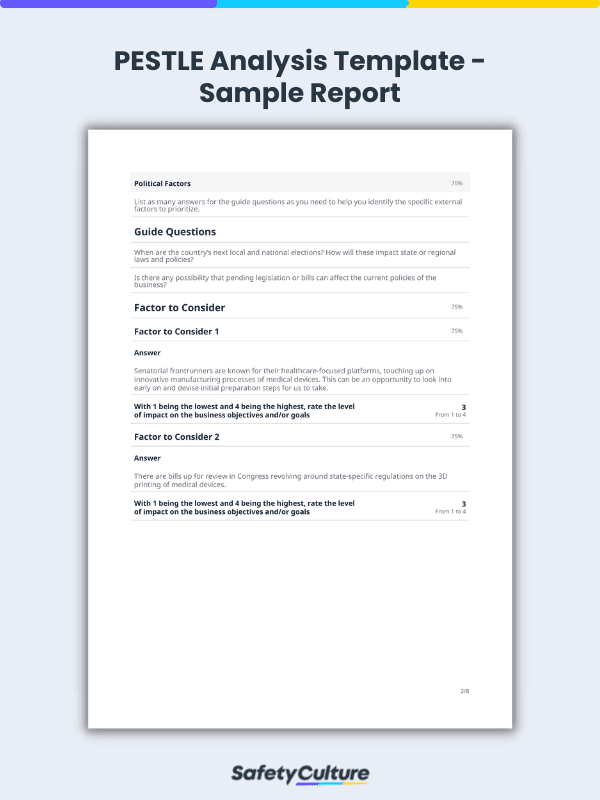What is a PESTLE Analysis Template?
A PESTLE analysis template is a digital tool used by organizational leaders and business analysts in listing and documenting relevant factors to be considered as a result of macro-environmental scanning and how they impact an organization’s goals and objectives using the PESTLE analysis method. Based on the acronym Political, Economic, Social, Technological, Legal, and Environmental, the PESTLE template also has other forms such as PEST and PESTEL templates which also serve the same purpose of helping those who use it to streamline their process of performing the analysis.
Benefits
Commonly, organizations that are able to monitor and adapt to changes that come from or are caused by external factors or the macro-environment can work on improving their competitive advantage over others. One way to do this is through conducting regular PESTLE analysis, which is considered one of the most common tools of environmental analysis.
Often, the ones responsible for this are business analysts, whether internal or external, as well as leaders and managers in charge of strategic decision-making in an organization. For most industries, this kind of analysis is repeated every 6 months on an ideal basis. This is to ensure that organizations are well up-to-date with what’s happening outside their organization and how it can affect their operations or processes. On the other hand, businesses in industries that are more fast-paced and ever-changing can opt to conduct PESTLE analysis as frequently as they deem fit to properly prepare for any changes and major decisions they must make.
Using straightforward, easy-to-use templates while conducting PESTLE analysis helps cut down the time it takes to list all factors and details under each consideration. Since such factors can be quite complicated, being able to streamline processes of identifying and addressing PESTLE factors using smart tools and platforms will be helpful toward a sustainable system of business growth planning. Hence, having a standard template can help reduce the need to repeat tasks and processes when preparing for PESTLE analysis sessions especially when it’s conducted regularly.
What to Include in a PESTLE Analysis Template
Those in charge of conducting a PESTLE analysis must be fully aware of what sections to include in a PESTLE analysis template. This will help them ensure that no key factor—whether Political, Economic, Social, Technological, Legal, and Environmental—is left out and not addressed. Otherwise, it can lead to lost business opportunities or hampered operations in the short and long term.
That said, here’s a quick guide on how to create a PESTLE analysis template and some common guide questions under each PESTLE factor you must consider.
Allot a page for the introduction or analysis brief.
The first part of your template must be able to lay down the objectives of why the analysis is being conducted. If a specific project is underway and the goals you’ve set for it are likely to be impacted by external factors, make sure that the need to perform the PESTLE analysis is clear and well-discussed to those involved beforehand and reiterated on the template once the analysis starts.
Dedicate separate pages for each of the PESTLE categories.
For a more effective way of understanding and documenting specific points under each area of the PESTLE analysis, it’s best to organize all questions and answers about one area on one separate page. As such, here are some sample questions to answer when qualifying the factors you’ll list as relevant to your business and its objectives:
Political Factors
- When are the country’s next local and national elections? How will these impact state or regional laws and policies?
- Is there any possibility that pending legislation or bills can affect the current policies of the business?
Economic Factors
- What are the specific and general economic factors most likely to affect our business in the long run?
- How does the current economic environment of the country and/or of the international market impact the business?
Social Factors
- What purchasing motivators best represent our customers’ behavior?
- How do we qualify our leads and prospects based on how their values and beliefs relate to our business?
Technological Factors
- How do we keep track of technological advancements?
- What are the emerging technologies that are highly relevant to our business?
Legal Factors
- What are the most relevant laws and regulations that apply to our business?
- How should we align our global campaigns to ensure we’re complying with regional laws and regulations?
Environmental Factors
- How does our workplace location affect the growth of the business?
- Are there any other physical environment-related factors we need to consider as we conduct our business strategy planning?
Include a completion page.
The last page of your PESTLE analysis template must also include a section or one whole page to account for the following:
- Other notes or reminders
- Recommendations and next steps
- Analysis facilitator sign-off
Sample PESTLE Analysis Template
Here’s an example of a PESTLE analysis template when used in SafetyCulture:
FAQs About PESTLE Analysis Template
Following the structure of the sample template discussed above, writing a PESTLE analysis template entails these easy steps:
- Allot a page for the introduction or analysis brief.
- Dedicate separate pages for each of the PESTLE categories. Include guide questions to establish proper context.
- Include a sign-off page.
While the questions may vary per area or section in the PESTLE analysis, some of the most common ones include the following:
- Is there any possibility that pending legislation or bills can affect the current policies of the business?
- What are the specific and general economic factors most likely to affect our business in the long run?
- How do we qualify our leads and prospects based on how their values and beliefs relate to our business?
- What are the emerging technologies that are highly relevant to our business?
- How should we align our global campaigns to ensure we’re complying with regional laws and regulations?
- Are there any other physical environment-related factors we need to consider as we conduct our business strategy planning?
The external factors being identified, discussed, and analyzed in PESTLE analysis can cover or contribute to the Opportunities and Threats areas of SWOT analysis (Strengths, Weaknesses, Opportunities, and Threats). Hence, a PESTLE analysis template is greatly helpful in connecting an organization’s strategic analyses and environmental scanning processes.




